
Spring crocus: planting, growing and care
Contents
Crocus in a nutshell
- It is one of the very first flowers of spring!
- It offers a delicate flowering in white, purple, or yellow.
- The crocus is easy to grow, hardy, and not very susceptible to diseases. It mainly needs well-draining soil.
- It is the ideal plant to flower a short grass meadow or the base of trees! But it can also be grown in pots or rockeries.
- It can naturalise and form vast tapetum of flowers!
A word from our Expert
Crocus is a bulbous perennial that blooms very early in spring, even as early as the end of winter. It is a flower of rare simplicity, yet its colours and contrasts seem very well thought out. It breaks through the snow and awakens the garden, instantly making us forget the cold and gloom of winter! It is moving in its fragile and delicate appearance. It is a plant with soft shapes and extremely fine foliage.
Crocus requires little attention: it is easy to grow, very hardy, and tolerates poor soils! It just needs well-drained soil and sunlight. Moreover, after flowering, it enters a state of dormancy and requires no further maintenance. Once established, it naturalises easily and can form large carpets of flowers! Crocuses easily find their place in the garden, whether in the short grass meadow, in rockeries, or in window boxes. They take up little space!
At the end of winter, it stands ready, its flower buds poised to bloom at the first rays of sunshine, at the first signs heralding spring… And then, it’s an explosion of colour! The carpets of Crocus tommasinianus covering the short grass meadow, enhancing the base of trees, bringing colour and life to the garden. To quickly forget winter and move on! A new year begins in the garden…
Once its flowering is over, it will enter a state of dormancy and will be forgotten. It will humbly make way for other plants… only to reproduce the same spectacle the following year! What a pleasure to find it again each year, as if it were giving us an appointment in spring!
Botany
Botanical data
- Latin name Crocus sp.
- Family Iridaceae
- Common name Crocus
- Flowering between February and April
- Height between 8 and 15 cm
- Exposure sun to partial shade
- Soil type well-drained
- Hardiness -15 to -20 °C
Crocuses are perennial plants that grow in meadows and clearings, mainly in mountainous regions. They can be found in Europe, Asia, the Middle East, and as far north as Africa. Many crocuses are native to Eastern Europe and the Balkans. In France, there are six spontaneous species, two of which are found only in Corsica!
There are nearly 80 species of crocus. These are perennial plants with corms (pseudo-bulbs serving as storage organs). The majority of them flower in spring, with a few blooming in autumn. The crocus belongs to the Iridaceae family, which includes 1,800 species, mainly herbaceous, such as Iris, Gladioli, Freesias, and Crocosmias. The term “autumn crocus” is incorrectly applied to Sternbergia lutea, which does not even belong to the Iridaceae family. The crocus can also be confused with colchicum.
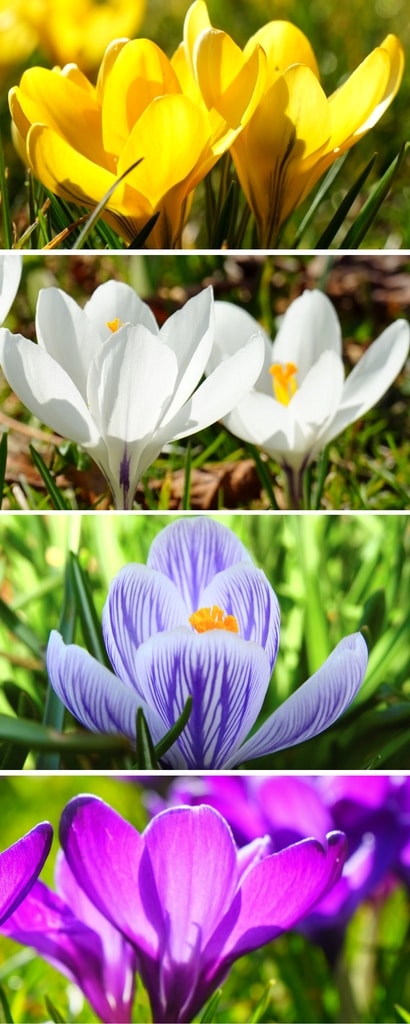
Crocuses offer a very bright palette of colours!
Its name comes from the Greek krokos: saffron. Indeed, saffron is derived from a crocus, Crocus sativus. It is obtained by harvesting the reddish-orange pistil. It is the most expensive spice, as it takes about 150 flowers to collect just one gram! Since this crocus blooms in autumn, we will not discuss it here.
There are two main categories of spring crocuses: Dutch hybrids, which are large-flowered varieties derived from Crocus x vernus, and botanical crocuses that bloom earlier (sometimes as early as January or February!) and have smaller flowers with a more natural appearance.
Crocuses are small plants that measure between 8 and 15 centimetres in height. They do not take up much space in borders but can form an impressive carpet of flowers! This is the case with Crocus tommasinianus. It is advisable to plant them in groups. It is common for crocuses to naturalise in the garden!
Spring crocuses flower as early as the end of winter, between February and April… sometimes even as early as January! They can pierce through the snow! As soon as temperatures warm up, the flower buds begin to open. The flowering period generally lasts between ten and fifteen days. The flowers open with the sun: they close at night and when the sky is grey… the crocus thus acts as a barometer!
The flowers of crocuses are spreading, cup-shaped, and remind us of the flowering of colchicums. Their gentle shapes give them an emotional, fragile quality. They are composed of six tepals (indistinguishable petals or sepals). They can be white, purple, or yellow. They are often very bright! The ‘Mammoth’ series includes varieties selected for their large flowers. At the centre of the flower, the yellow-orange stamens provide a striking contrast against the petals, especially when the latter are white or purple!
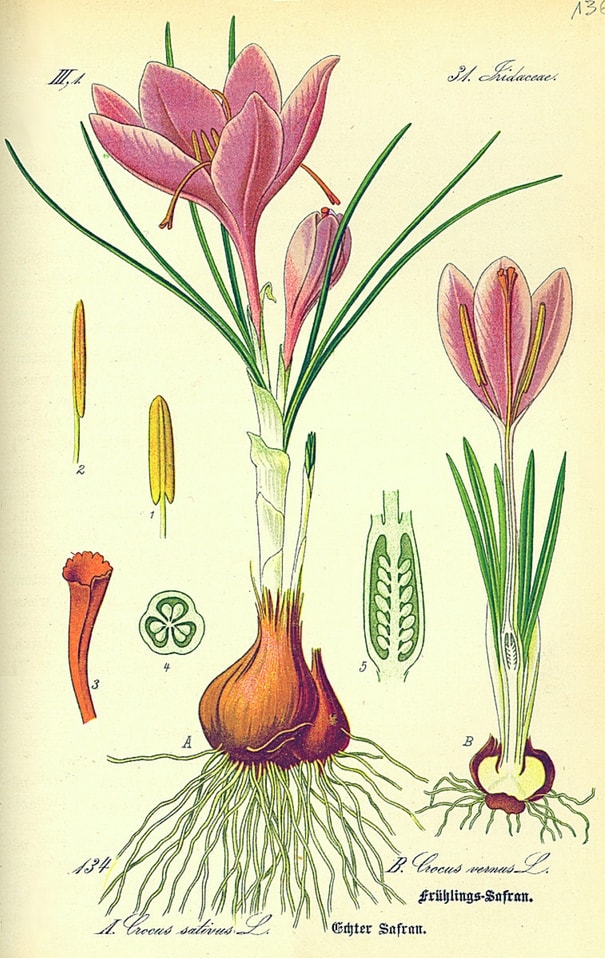
Crocus sativus and Crocus vernus: botanical plate
Some varieties, particularly those derived from Crocus chrysanthus, are fragrant! Their flowers then release a light honey scent.
The leaves of crocuses are narrow and linear. They have a lighter central vein and often measure 10 to 15 centimetres in length. Generally, they grow at the same time as the flowers. However, after flowering, they elongate! Then, at the end of spring, the foliage turns yellow, and the plant enters a dormancy period. It will then require no maintenance. There will be no need to water it; on the contrary, the bulbs prefer to remain dry!
The crocus produces corms: these are pseudo-bulbs composed of a swollen stem surrounded by scales. Storage organs, they allow the plant to store nutrients to survive part of the year in dormancy and then bloom again in spring. It is easy to multiply crocuses by taking these corms.
Crocuses are sometimes sold in mixes that combine a large number of bulbs of different varieties. This is a good solution for flowering a lawn, but one might prefer to choose the colours oneself to create a harmonious ensemble… and thus limit oneself to a more restricted palette.
Botanical species:
- Crocus chrysanthus
Native to Eastern Europe, this species offers an earlier flowering than Dutch hybrids. Its flowers are also smaller, giving them a more natural style. It bears yellow flowers but has led to the creation of many varieties with flowers that are sometimes white or blue, such as ‘Blue Pearl’.
- Crocus vernus
This crocus bears purple or white flowers with yellow stamens. It is found in mountainous regions, from Eastern and Central Europe, from Western Russia to Italy. It has given rise to many Dutch hybrids with very large flowers.
Native to Eastern Europe, this very prolific crocus spreads on its own and tends to naturalise! It is one of the first to bloom, sometimes as early as February. Moreover, unlike other varieties, it tolerates shade! Thus, you can grow it in woodland. Its flowers are lilac or purple.

The blooming of crocus flowers!
The main varieties of crocus
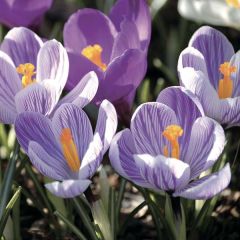
Crocus vernus Pickwick
- Flowering time April
- Height at maturity 15 cm

Crocus vernus Jeanne dArc
- Flowering time March, April
- Height at maturity 15 cm
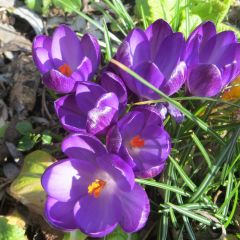
Crocus tommasinianus Ruby Giant - Early Crocus
- Flowering time March, April
- Height at maturity 15 cm

Crocus vernus Remembrance
- Flowering time March, April
- Height at maturity 10 cm
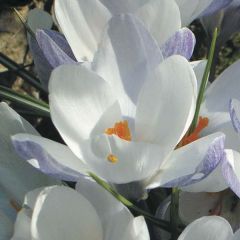
Crocus chrysanthus Blue Pearl
- Flowering time March, April
- Height at maturity 12 cm

Crocus chrysanthus Cream Beauty
- Flowering time March, April
- Height at maturity 10 cm
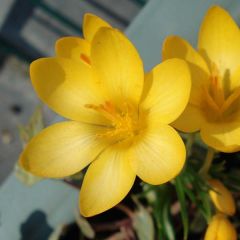
Crocus ancyrensis
- Flowering time March, April
- Height at maturity 10 cm
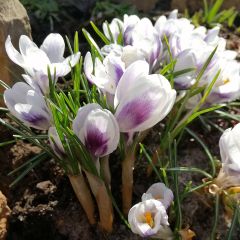
Crocus Prins Claus
- Flowering time March, April
- Height at maturity 12 cm
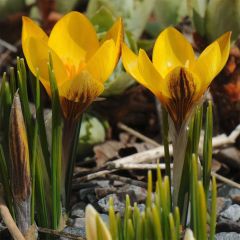
Crocus chrysanthus Fuscotinctus
- Flowering time March, April
- Height at maturity 10 cm
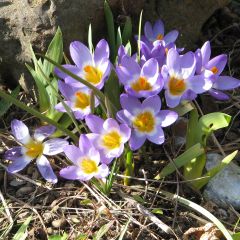
Crocus sieberi Tricolor
- Flowering time March, April
- Height at maturity 10 cm

Crocus vernus Vanguard
- Flowering time April, May
- Height at maturity 10 cm
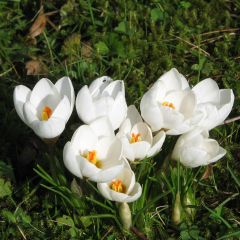
Crocus chrysanthus Snow Bunting
- Flowering time March, April
- Height at maturity 10 cm
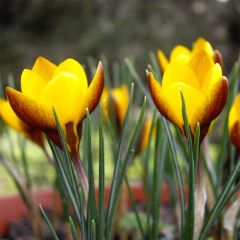
Crocus chrysanthus Zwanenburg Bronze
- Flowering time March, April
- Height at maturity 15 cm
Discover other Spring Crocus
View all →Available in 1 sizes
Available in 1 sizes
Available in 0 sizes
Available in 1 sizes
Available in 1 sizes
Available in 0 sizes
Available in 1 sizes
Available in 0 sizes
Available in 0 sizes
Available in 1 sizes
Planting Crocus
Where to plant?
We recommend planting your crocuses in groups, with at least five bulbs together, ideally around ten. You can cluster them to create splashes of colour in a short grass meadow, or place them more randomly.
Crocuses are easy to grow. There are just two conditions for success: a draining soil and sunlight! They do not like moisture and will thrive in a site exposed to full south! However, Crocus tommasinianus grows well in the shade.
Crocuses prefer light soils! They can be stony and poor. If your soil is clayey, you will need to make it more permeable by adding pumice or gravel. It is not a problem if the soil dries out during the summer, on the contrary! As the crocus is in a dormant state, it prefers to stay dry. Avoid placing it, for example, under an automatic lawn watering system or next to plants that require regular watering. The bulbs could rot.
You can also plant them in pots or window boxes, alongside other bulbous plants, as well as in rockeries… or even install them on a green roof! In a border, to protect them, you can place them among perennials that will cover them, such as ground cover plants or plants that start their growth once the crocuses have finished flowering.
When to plant?
Plant your crocuses in autumn, between September and November, avoiding frost periods. By planting them early enough, you will achieve a slightly earlier and better quality flowering than if you plant them at the end of November or in December.
How to plant?
Planting crocuses is quite simple. Maintain a distance of around ten centimetres between each bulb. We recommend using a bulb planter.
Arrange the bulbs on the soil, randomly for a more natural effect. Feel free to toss them and plant them where they fall! Dig a small planting hole for each bulb, about ten centimetres deep. Drain the bottom if necessary with a thin layer of gravel or clay pebbles. Position the bulbs the right way up, with the point facing upwards. Replace the soil and firm it down. Generally, there is no need to water.
Do not hesitate to plant your bulbs densely, by digging a wide hole and placing them all together, side by side, but not touching. This will create beautiful splashes of colour! If you are installing your bulbs in a lawn, detach a patch of turf, plant, and then replace it. This way, you will not damage your grass!
Place markers to remember where you planted your bulbs and avoid digging them up later. If you are planting your crocuses in a border, we recommend planting all your flowers at the same time, to avoid damaging the bulbs by later hitting them with a spade!
Discover our video tips for planting crocuses with a bulb planter!
Pot planting:
You can plant your crocuses in pots or window boxes. Use a wide and shallow container. Drain the bottom with a layer of gravel or broken pot pieces. Fill it with potting soil mixed with a bit of sand. Place your bulbs point up and fairly close together, then cover them with substrate. Firm gently.
Read also: Growing crocus in pots.
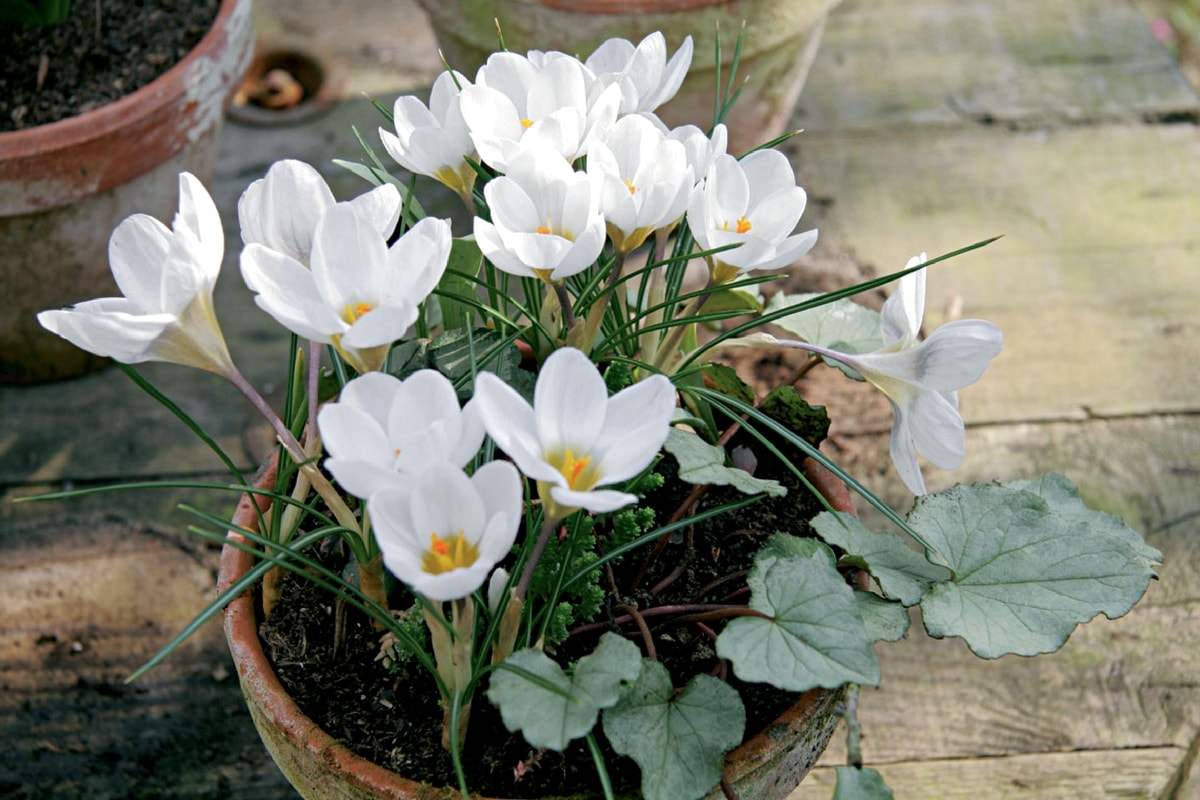
Crocus chrysanthus ‘Miss Vain’ and Cyclamen of Naples in pot
Care
Crocus is really easy to grow, and its maintenance is almost non-existent. It mainly needs to be kept away from moisture and you should not cut its leaves before they have dried! Generally, maintenance consists simply of removing faded flowers. And dividing the corms after a few years, if flowering declines, to restore their vigour.
Crocus are resilient and do not really have problems with diseases or pests, apart from rodents (squirrels, mice, voles, and gophers), who delight in digging up and nibbling the bulbs! Protect them with wire mesh. Or plant alongside your crocus other toxic bulbs that rodents avoid: for example, snowdrops or daffodils.
Once flowering is over, the leaves elongate and then yellow. Crocus are in the process of replenishing their reserves to be able to flower the following year… So refrain from cutting the leaves before they are completely dry! Wait for the plant to be in vegetative dormancy before mowing the short grass meadow.
Leave your crocus in place after flowering. Once dormant, crocus will require no further maintenance. You do not need to water it, quite the opposite! It does not appreciate moisture, and the bulbs could rot.
To advance flowering, you can force the bulbs by subjecting them to a cold period. Plant them in pots in October, in a light and draining substrate, then place them in darkness and cool conditions (no more than 10 °C), for example in a cellar or garage. Water regularly. After two months, when the first shoots measure 5 to 10 centimetres, take them out and place them at room temperature, in a bright spot near a window. This way, you will enjoy flowering in the middle of winter!
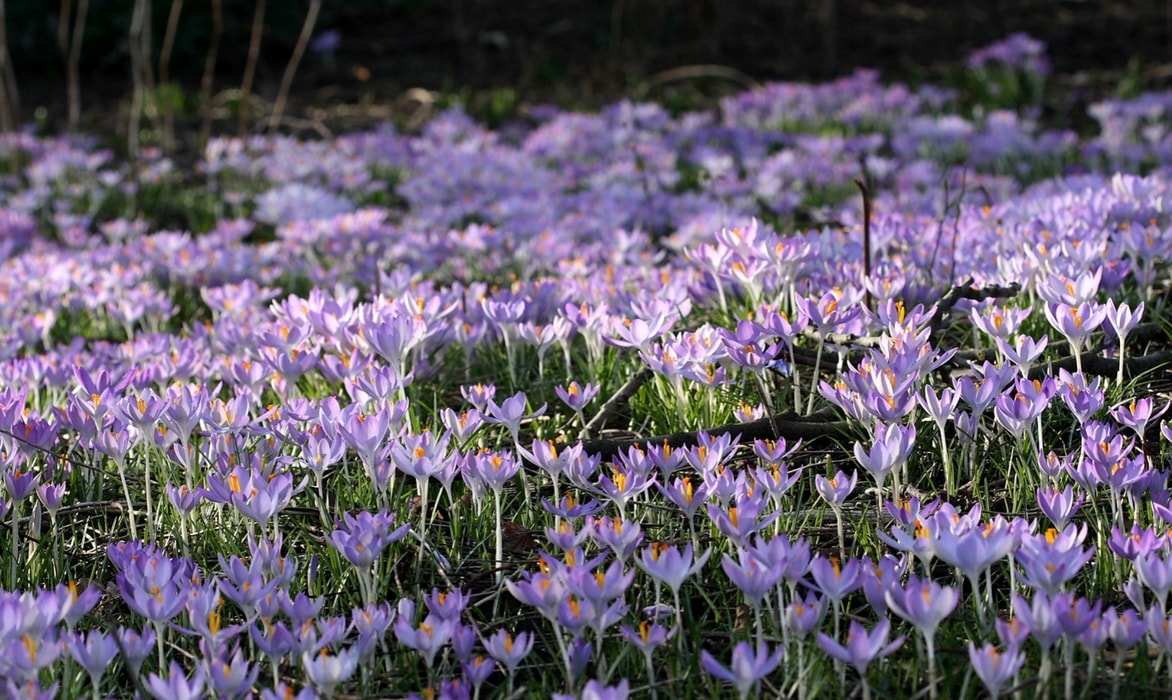
Crocus tommasinianus can form real carpets in woodlands! (photo L. B. Tettenborn)
Propagation
Crocuses tend to naturalise easily. This is particularly true for Crocus tommasinianus, which self-seeds and forms colonies, creating true carpets of flowers. We recommend multiplying them by dividing the corms, a technique that is much more reliable and quicker than sowing.
Division of corms
By dividing crocus corms, you can easily and quickly obtain new plants.
Crocus multiplies spontaneously by producing new corms. We advise dividing your crocuses every four to five years. This helps to regenerate the clumps and make them more vigorous.
Divide the corms at the end of spring or in summer, starting from May. At this time, the foliage turns yellow and the plant enters a dormant phase. Dig up the corms with a spade, digging wide enough to avoid damaging them. Separate the bulbils that have formed next to the original bulb. Replant them in groups, point upwards, at a depth of about ten centimetres. Cover with soil and firm down. There is no need to water.
Sowing
You can collect your crocus seeds and sow them, but this technique takes time, and you may have to wait two to three years before seeing them flower. Additionally, if you sow horticultural varieties, you risk obtaining flowers with slightly different colours from the original variety.
In spring, collect the seeds and sow them immediately. Fill a pot with substrate up to a few centimetres from the top. Disperse the seeds evenly and fairly densely, then cover them with a thick layer of potting soil: they need to be sown quite deep. Water and place the pot under a cold frame. You will need to wait two years before planting your young plants in the ground.
Association
Crocus allows you to have flowers as early as the end of winter. Take advantage of this to create a colourful bed very early in the season! Pair it with other early-flowering bulbs, such as daffodils or chionodoxas. You can add some Oriental Hellebores or stemless Primroses.
Crocus is perfect for flowering a short grass meadow. Choose Crocus tommasinianus, as it tends to naturalise! It will cover the ground with a beautiful lilac-coloured tapetum! Tolerating partial shade, it can even be planted in woodland and flower at the base of trees. The snowdrop and the spring snowflake will accompany it easily. Enjoy the yellow flowering of Eranthis hyemalis to bring colour and brightness to your garden!
Crocus adapts to various uses: you can grow it in a container alongside other perennials or bulbous plants. It can also be planted in rockeries, or even on a green roof! This is due to its drought resistance and ability to thrive in poor soil. Pair it with alpine plants or succulents, such as saxifrages, houseleeks, or cerastium.
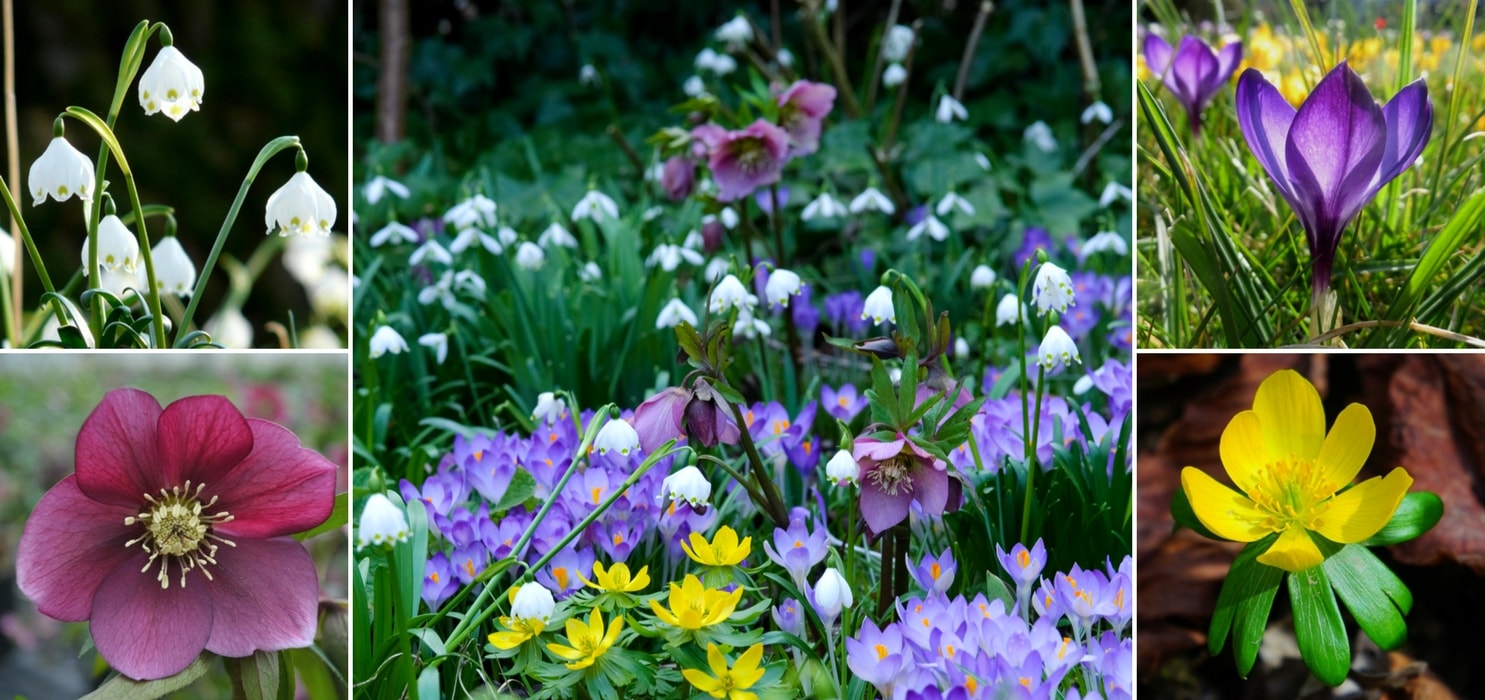
A spring scene in woodland with Leucojum vernum, Helleborus x hybridus, Crocus tommasinianus, and Eranthis hyemalis! (Photo Credit GAP Howard Rice)
Also discover our advice sheet: “Crocus: how to choose and associate them well”
Did you know?
In the language of flowers, crocuses have different meanings depending on their colour. Those with yellow flowers carry a message of fear and anxiety regarding romantic feelings. They signify a need for reassurance. White crocuses express joy and happiness associated with youth, while blue ones symbolise a blossoming love.
In Greek mythology, Crocus was a man in love with the nymph Smylax. As she was indifferent to his charms, the gods transformed him into a crocus to ease his sorrow.
In another version, Crocus was a friend of Hermes. The latter accidentally and fatally wounded him during a discus throw. Three drops of his blood fell to the ground and caused a remarkable flower to grow, which was named after him, Crocus.
Useful resources
- Our wide range of spring crocuses!
- Advice sheet: “Crocus, how to plant them”
- Advice sheet: Which bulbs to grow indoors?
- Advice sheet: Bulb size: understanding to choose better
- Advice sheet: 6 bulbs to naturalise in the garden
- Advice sheet: 5 bulbs that flower in early winter
- Crocuses by flowering colour: Yellow flowering crocuses, the best varieties, The best varieties of white flowering crocuses for your garden, Top 5 varieties of purple flowering crocuses.
Frequently asked questions
-
I planted crocuses, but they are not shooting. I can't find them anymore!
Your bulbs have likely been eaten by rodents (mice, voles, or squirrels), who enjoy digging them up and nibbling on them! To protect them, we recommend installing a mesh or planting other bulbs among your crocuses that they will avoid, such as snowdrops or daffodils. Additionally, these plants bloom at the same time and pair perfectly with crocuses! If they are not growing, it is also possible that the growing conditions are not suitable for them: soil that is not well-draining, a bit too much moisture... the bulbs may then rot! Crocuses prefer to have their feet dry, especially when they are in a dormant state.
-
My crocuses are not flowering, or only a few are. What should I do?
If the flowering of your crocuses is dwindling, you need to divide the corms to restore their vigour. This should be done at the end of spring, around May, when the plant enters its dormant phase. Dig up the corms, separate them, and replant them. We recommend dividing them every four to five years. If your crocuses are struggling to flower, it may also be due to a lack of light. Except for Crocus tommasinianus, which thrives in partial shade, most varieties require full sun to bloom! If they are in the shade, dig them up and relocate them to a sunny spot.
-
The flowering is over. Should I remove my bulbs to store them?
No. Even if you are tempted to dig them up to protect them from moisture or rodents, it is better to leave them in place!
-
Can I plant my crocuses in winter?
Planting is possible in November, possibly in December, especially if you live in a region with a mild climate. Choose a variety that flowers quite late, such as Crocus vernus (for example, ‘Pickwick’ or ‘Jeanne d’Arc’). It’s not ideal, but it’s better to plant them even if it’s in January rather than keeping them for planting the following year.
-
Should I add fertiliser?
No, it is not necessary. Crocuses are low-maintenance and grow very well in poor soil. You can add a bit of fertiliser if you are growing them in pots. But generally, the fertiliser included in potting soils is more than enough to meet the needs of crocuses.
-
Can I mow after flowering?
No, it is essential to avoid cutting the leaves of crocuses! Once the flowering is over, the plant stores its reserves and prepares to enter dormancy. You must wait until the leaves are completely dry and the plant goes into vegetative rest. After that, you can easily mow your short grass meadow.
-
Can I plant in partial shade?
Yes, crocuses can tolerate a slightly shaded situation if they can enjoy a few hours of sun in the afternoon, or if you place them under deciduous trees. If not, choose Crocus tommasinianus, as it tolerates shaded conditions well!
- Subscribe!
- Contents































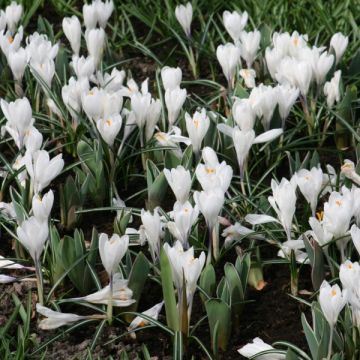
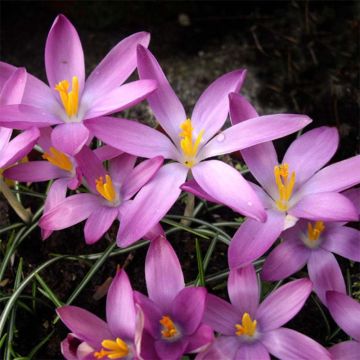
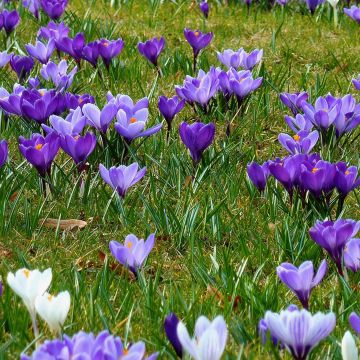
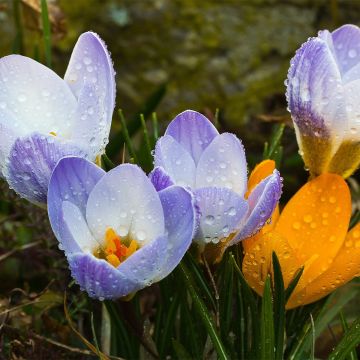

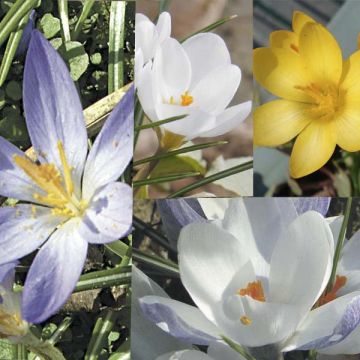
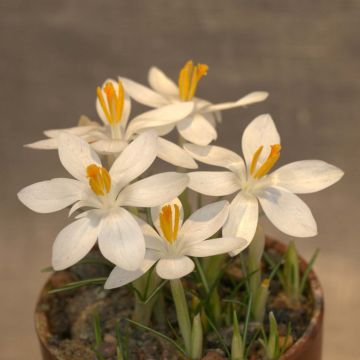
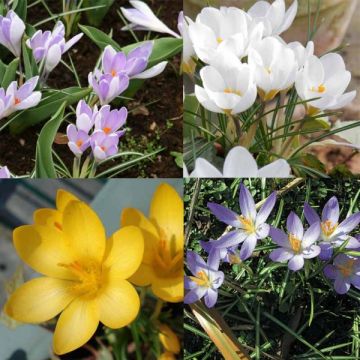
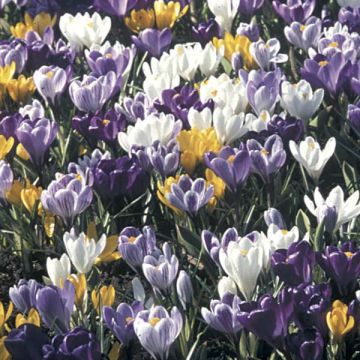

Comments